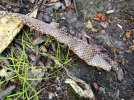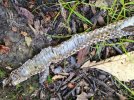Hematoxic venom...I wonder if that implies the venom travels thru or interacts with blood differently than our local snakes...if so my last post may not be completely appliccable (altho I think it would still help). Definitely get first aid trained for the local nasties

In the meantime Im curious about US procedures if there is someone in the know around...
Full discloser. I am no expert on anything so take this with a gain of salt.
I believe it attacks the vascular systems and blood. Other types of venom are neurotoxic aka Cobra etc. Also there are some differences within populations. For example the Canebrake is a southern population of timber rattlers which has a mix of both toxins. There is also a population that has a milder venom. The Northern population will do some serious tissue damage and like all pit vipers their delivery system is advanced.
It isn't always about how toxic a snake's venom that determines which one is the most dangerous to humans. It is about attitude, proximity to populated areas, venom delivery system and the venom. I think more people in a percentage terms are bitten and killed within the USA than Australia but could be wrong. This despite Australia having some really really toxic snake venoms.
Maybe this discrepancy might have something to due with New World pit viper behavior or maybe human behavior differences within the context of snake encounters. In any case most people are hit when attempting to handle or harm them. Which is rather ironic because some people kill them as a preventive cure to being bitten. If they just walked away nothing would have happened. I guess that applies to many of life's problems.
Here are a few rattlesnake myths or facts. Keep in mind my only interactions have been with Eastern Diamond Backs and Timbers.
1. They ALWAYS rattle a warning.
Sometimes they do like this one however other times not.

Their primary defense beyond the venom is a surprisingly good camo.

2. They are nasty and will strike first, ask questions later.
Even the nastiest most pissed off rattlesnake I have seen really was trying its best to get away. They never seem to be in a hurry to go anyplace but the direction was always away from me. This isn't to say they won't defend themselves by striking first.
3. Timbers are docile. Yes until they're not. Never never never think a wild critter's behavior can be predicted with total confidence. I have accidentally walked right over a Timber during a night hike. If not for the person behind me I wouldn't have even known it. Betting lots of people had close aka within easy strike range encounters and didn't know but I wouldn't put anything to the test.
4. Eastern Diamond Backs have the most toxic venom of any North American snake. No and within populations there is a range however the pure volume of venom makes up for that IMHO.
5. Baby rattlesnakes are more dangerous than adults. Maybe or maybe not. Is there a higher percentage of hot hits compared to adults? Don't know but then again I am not going to put this to the test.

















